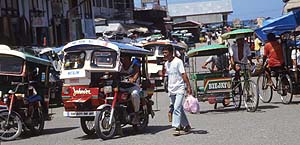
Motor tricycles,
cycle rickshaws, cycles and other transport technologies near a
market in the Philippines. |
|
The diversity of local transport solutions
can be clearly seen in the vicinity of markets. Markets involve
the inward and outward transport of many goods and they attract
many people (traders and customers). This creates many different
transport markets (people/goods, nearby/distant, light/heavy, prestigious/
economical). Around markets there may be production and repair facilities,
raw materials and scrap yards. The wide range of transport solutions
seen in close proximity illustrates both the diversity and the complementarity
transport devices. The different local transport solutions offer
a different combination of design compromises between cost, weight,
carrying capacity, manoeuvrability, speed, durability and aesthetic
characteristics.
|

